Europe
Asia Pacific
North America
South America
Middle East
South Africa
Summary of the ocean freight market update in March
The US has restarted military strikes on Houthi positions in Yemen. The Houthi have said they will ban US vessels from navigation of the southern Red Sea, Arabian Sea, and Gulf Aden, and that it will target US Navy ships in response to US airstrikes on Yemen. In January this year, the Houthi lifted its 'ban' on international shipping transiting the Red Sea as the ceasefire between Israel and Hamas progressed, but warned that aggression against its forces in Yemen by the US or UK would make the nations’ vessels subject to attack once again. Recent strikes by Israel have put a continued ceasefire in jeopardy. This could raise hostilities by the Houthis towards Red Sea merchant vessels.
The Organisation for Economic Co-operation and Development (OECD) has revised its US GDP forecasts down from 2.4% to 2.2% for 2025 and from 2.1% to 1.6% for 2026. Global GDP was also revised lower, from 3.3% to 3.1% in 2025 and 3.3% to 3.0% in 2026. “Higher trade barriers in several G20 economies and increased geopolitical and policy uncertainty [is] weighing on investment and household spending,” the OECD said.
The European Union announced it was delaying its retaliatory tariffs on US goods to allow for “additional time for discussions with the US administration,” it was not seeking to “diminish the impact of our response,” it said, “in particular as the EU continues to prepare for retaliation of up to 26 billion EUR”.
Reuters reported Canada has requested WTO dispute consultations with the US over its imposition of import duties on steel and aluminum products from Canada. The tariffs, launched 12 March 2025, yielded an immediate response from the Liberal government, which slapped tariffs on US imports valued at nearly 30 billion USD on 13 March 2025.
Trade union action across major European ports, particularly in Rotterdam and France, have caused significant disruptions to container shipping, exacerbating existing supply chain challenges. Strikes at Rotterdam’s Delta II terminal and ongoing industrial action at French ports have created congestion, delays, and logistical bottlenecks, prompting carriers to reroute vessels and seek alternative solutions.
Drewry anticipate a continued general decline in global container rates in the coming weeks. This is attributed to an expected increase in container shipping capacity, which could further soften freight rates across various routes. That includes new vessels entering service, and a possible return by major carriers to the Red Sea and Suez Canal. The Suez continues to be the wild card that could cause a marked decrease in rates if a reopening were to occur.
Energy Price - March 2025
20 February 2025 = 76.48 USD
20 March 2025 = 72.00 USD
- OPEC+ on 20 March 2025 issued a new schedule for seven member nations to make further oil output cuts to compensate for pumping above agreed levels, which will more than overtake the monthly production hikes the group plans to introduce next month. The plan will represent monthly cuts of between 189,000 barrels per day and 435,000 bpd. The scheduled cuts last until June 2026. (OPEC)
- With the overall Chinese economy pivoting from manufacturing to services-based growth and as the adoption of electric vehicles expands in the transport sector, the data strongly suggest that the combustion uses of petroleum fuel in China have already reached a plateau and that the potential for future growth may be very limited. (IEA)
- US Secretary of Energy, Chris Wright, has approved an LNG export authorisation to the Venture Global CP2 LNG export project proposed for Cameron Parish, Louisiana. “The benefits of expanding US LNG exports have never been more clear, and I am proud to be taking action to support the American people and our allies abroad with more affordable, reliable, secure American energy,” said Secretary Wright.
- Tech giants and other major energy users Amazon, Google, Meta, Dow, Occidental, Allseas and OSGE have signed a pledge supporting the goal of at least tripling global nuclear capacity by 2050. The announcement, at CERAWeek 2025 in Houston, Texas, in the US, of the Large Energy Users Pledge, follows earlier pledges by 31 countries, by 140 nuclear industry companies and 14 major global banks and financial institutions to support the tripling goal.
- Sales of bunkering fuel at top hubs around the world have slowed down due to growing geopolitical uncertainty and Trump’s tariff offensive, Reuters has reported. “Shipping companies are now optimising their operations more cautiously to navigate volatile tariff conditions and geopolitical instability,” the chief executive of a container trading platform told Reuters, adding “The slowdown in marine fuel demand is a reflection of the broader uncertainty in global trade.”
Ocean freight trends - Europe
- Weakening demand from the Far East to North Europe has resulted in MSC redeploying 19,200 TEU to 24,300 TEU vessels to sail on Far East – Med services away from North Europe.
- Return to Red Sea routing appears to be delayed indefinitely due to return of hostilities.
- Severe congestion continues to plague ports across Europe.
Main Reasons for Bottlenecks
- Storms, strikes and record imports have all contributed to rising congestion in North European ports.
- Frequent vessel diversions to Antwerp have had a knock on impact which is now resulting in congestion issues.
- Blank sailings continue to impact schedule reliability.
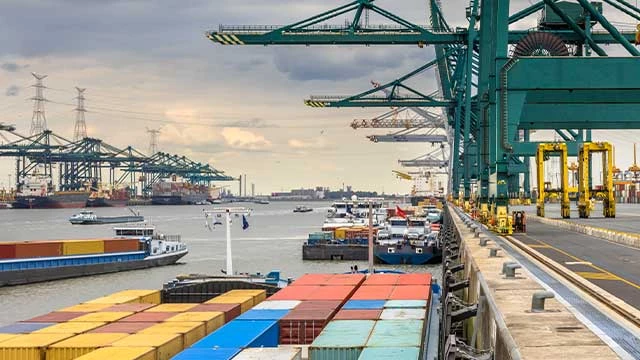
Impact on Freight Rates
- Long term rates from the Far East to Northern Europe continue to drop with rates up to 2,000 USD per FEU lower than those with short term validity.
- Carriers are having to provide discounts to secure long term contracts lasing more than 6 months.
- More shippers are moving to an indexing methodology for large volumes on key routes.
Outlook
- Long terms rates into Europe from the Far East are expected to be between 7% and 30% lower at the end of Q2 than current levels.
- Schedule reliability is an ongoing issue that doesn’t appear to be improving due to various market related challenges. Factor in 50% - 55% reliability into your schedule planning.
Ocean freight trends - Asia Pacific
- As of March 2025, the global shipping industry continues to navigate through a complex landscape by the evolving trends, emerging bottlenecks, fluctuating freight rates, and a cautiously optimistic outlook for the second quarter of 2025.
Main Reasons for Bottlenecks
- Nearly 11% (approx. 3.3 million TEUs) of the global fleet are tied up in port congestions across major ports in Asia, Europe, and North America. In Asia, it is mainly the Chinese ports along Yangtze and Pearl River Deltas. This congestion is driven by the surge in post-Lunar New Year shipments, adverse weather conditions (heavy fog) and the ongoing supply chain disruptions.
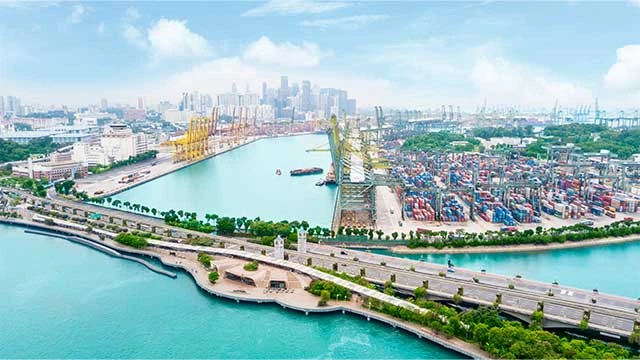
- Introduction of numerous ultra-large container ships has led to a demand-supply imbalance. New vessels outpacing demand leading to potential rates volatility.
- Effects from port congestion is observed in Europe (port strikes in France and Rotterdam) and this is causing disruption to vessel schedules returning to Asia. We should expect this phenomenon to stay for the next 2-3 months. As a result, capacities may be reduced as early as April and May.
Impact on Freight Rates
- Recent general rate increases (GRIs) by Asia-Europe carriers have led to a rise in rates on key routes from Asia to Europe by over 20% from 1 March 2025.
- Hapag Lloyd announced GRIs affecting shipments from Asia (China, Japan and Singapore) to Oceania (Australia and New Zealand) on all container types.
- Similar GRIs are also introduced for shipments from Asia and Oceania to the Middle East and the Indian subcontinent from the same effective dates.
Outlook
- The sea freight market in 2025 is projected to experience moderate demand growth, estimated at 3% to 4%. However, lower consumer demand and the increased tariffs in key markets, especially the US market, may temper this growth. Manufacturing indices in major regions, such as China and Europe, remained suppressed and is limited demand potential.
- Geopolitical uncertainties are continuing to loom the market. Trade policies remain a critical factor, with proposed tariff increases in the US potentially reshapes the containerized cargo flows, particularly on Asian export routes.
- With the port congestions, overcapacities and geopolitical tensions, we urge all shippers to remain vigilant and adaptable to the dynamic environment and navigate their supply chain needs with caution in Q2 2025.
Ocean freight trends - North America
- The US Federal Maritime Commission (FMC) has now opened its own investigation into the maritime industry. The FMC is looking into various container shipping choke points around the world. One possible action they could take is to restrict entry to the United States of any vessel registered in the country related to the choke point. It is not exactly clear, but an example would be Panama flagged container ships facing restrictions in relation to issues with the Panama Canal. The seven choke points targeted by the FMC are the English Channel, the Malacca Strait, the Northern Sea Passage, the Singapore Strait, the Panama Canal, the Strait of Gibraltar, and the Suez Canal. They are accepting public comments until 13 May 2025.
- US Tariffs of 25% on all US steel and aluminum imports have now been enacted with a 1-month extension given on the proposed Mexico and Canada tariffs. The global Trump reciprocal tariffs are also to be implemented in early April which will level up US tariffs in line with other countries tariffs on US goods.
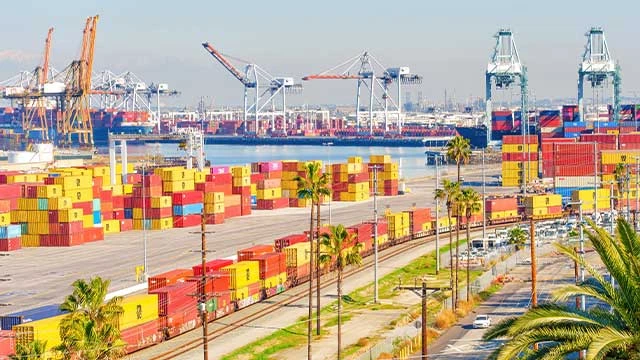
Main Reasons for Bottlenecks
- The surge in imports landing in Southern California during January amid a rush to beat new US tariffs and Lunar New Year factory closures has resulted in a significant buildup of empty containers awaiting a return trip to Asia in drayage yards and marine terminals. At the same time, US exports through Southern California are down, so most of the containers must be returned to Asia empty. (JOC)
Impact on Freight Rates
- Freight rates from Shanghai to Los Angeles decreased to 2,658 USD per 40ft container and those from Shanghai to New York decreased to 3,774 USD per 40ft container. Similarly, rates from Rotterdam to New York reduced to 2,316 USD per 40ft container. (Drewry)
- Average spot rates from Far East to US continue to decline, down 33% and 35% into the US East Coast and US West Coast respectively in March compared to one month ago. (Xeneta)
Outlook
- Drewry expects rates to decrease slightly in the upcoming weeks for lanes to the USA.
Ocean freight trends - South America
- The DP World Brazil Terminal, located on the left bank of the Port of Santos, has announced a strategic agreement with Maersk. The contract will come into effect in April of this year and initially provides for the operation of six services with eight weekly calls. From the second year onwards, with the expansion of the terminal's capacity, the number of services may increase to seven, with ten weekly calls.
- In January 2025, the Port of Santos reached the historic mark of 460.8 thousand TEUs, a growth of 12.1% compared to the same period in 2024, consolidating itself as the largest volume ever recorded for the month. Despite the increase in container movement, the total volume of cargo was 11.6 million tons, representing a drop of 2.5% impacted mainly by the 45.3% retraction in sugar and coffee shipments.
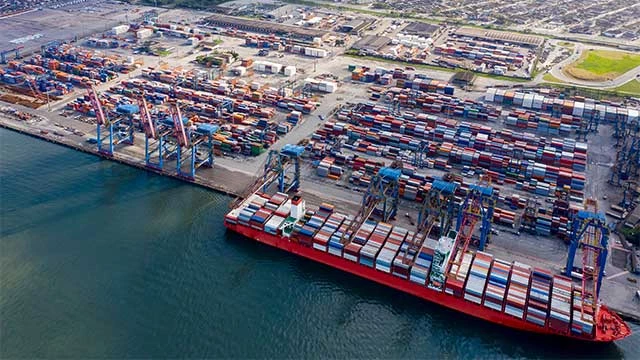
Main Reasons for Bottlenecks
- The impact of restrictions on the transportation of special cargo during the Carnival period, which ended on 5 March 2025, is still having considerable repercussions not only on the access roads to the Port of Santos, but also on the access roads to the Rodoanel. At least 3 girder bridges, 2 with a total gross weight of approximately 500 tons and 1 with a total gross weight of approximately 800 tons, are on the route. Due to the conditions of the infrastructure for access to the port and the lack of investment in teams to monitor special cargo, these cargoes that began transportation long before Carnival will only be able to complete access to the Port of Santos in the first week of April, causing further delays for other special cargoes, some of which will only be able to begin transit after these transportations are completed.
Impact on Freight Rates
- ZIM updated New Emission Fee (NEF) levels effective from 2 March 2025 till further notice, of EUR 89/TEU applying to FAK (Freight All Kind) cargo, in the trades Europe & Mediterranean to North America, West Coast South America, Caribbean.
Outlook
- The container fleet is expected to grow by 4.8% in 2025.
- Demand is projected to grow by 3% to 4% in 2025.
- Port congestion is expected to be a bigger problem in 2025.
- Carriers are already omitting certain ports from their rotations to streamline services.
Ocean freight trends - Middle East
- Long-term contract rates for trade lanes from China and the Far East to the Middle East have been declining for the past four months. While rates remain above pre-Red Sea crisis levels, the downward trend is continuing.
Main Reasons for Bottlenecks
- Dammam is still reporting a waiting period of 3 days. Port Congestion continues in Dammam due to cargo for Jeddah (West Coast) being routed to Dammam Sea Port on East Coast as ships continue to circumnavigate via Cape of Good Hope to discharge containers in Dammam Sea Port for pan KSA. 3 days waiting reported as of second week of February.
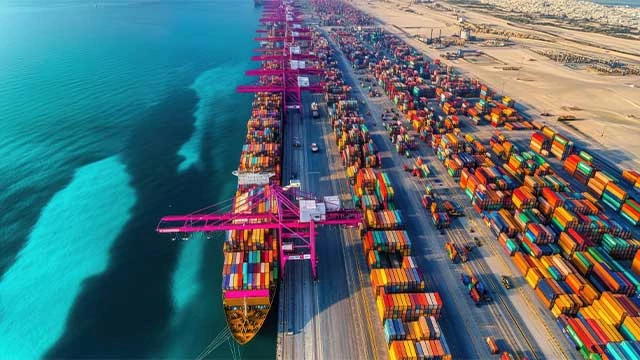
- Truck availability to pull out import full containers still continues and will get worse after the Eid Holiday i.e. first week of April.
- Continued congestion at Container Yard/s outside Dammam Port for returning empty containers, resulting in lower productivity/turnaround.
- Jebel Ali Port congestion has started to ease.
Impact on Freight Rates
- Rate erosion continues as exports have not yet picked up and volumes yet to pick up.
Outlook
- Europe to Middle East Rates will plummet.
- Expect carriers to start port omissions to consolidate cargo and push rates upwards.
Ocean freight trends - South Africa
- An average of ~9,212 TEUs was handled per day, with ~11,381 TEUs projected for next week.
- Rail cargo handled out of Durban was reported at 2,806 containers, up ↑8% from last week.
- Truck volumes through Lebombo increased to 1,516 HGVs/day (↑8%), with average crossing times 5.1 hrs.
- Cross-border queue: ↑1.2 hrs; transit: ↑0.8 hrs; SA borders: 8.2 hrs (↓25%); SADC: 4.4 hrs (on change).
- In January, global container volumes reached 15.4 million TEUs, marking a ↑5.8% year-on-year increase.
- Global spot rates dropped another ↓6.8% (or 173 USD) and now trade at around 2,368 USD per 40ft container.
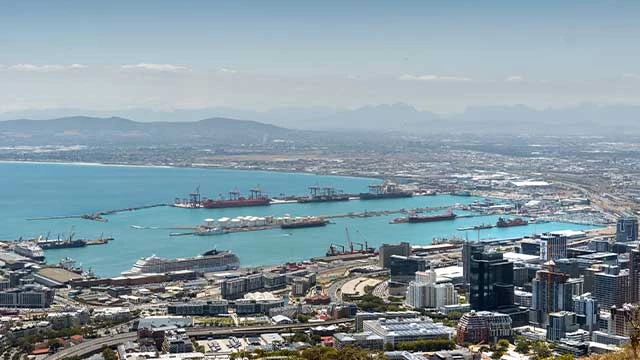
Main Reasons for Bottlenecks
- Port operations were mainly characterised by inclement weather, vacant berths, equipment breakdowns and shortages. The Port of Cape Town conceded more than 35 operational hours this week due to strong winds, adverse weather conditions and equipment breakdowns that disrupted operations in Durban.
- Vacant berths and inclement weather conditions resulted in operations delays at our Eastern Cape ports.
- The main operational constraints at the Port of Richards Bay proved to be adverse weather. The latest reports from Maersk suggest that the Maersk Iyo will omit the Port of Cape Town due to the continuation of adverse weather conditions at the port.
- The Santa Cruz faced a technical issue with her main engine en route to London Gateway from Cape Town.
- The main operational challenge on the rail network this week was the floods in and around Durban. The extent of the difficulties, however, remains undisclosed.
- Rail to Maputo increased to an average of seven trains a day in the last week, as sugar trains from Eswatini also increased – to around two trains a day.
- For the rest of SADC borders, the average queue times increased by around an hour from last week, as the transit times increased by slightly more than half an hour. The median border crossing times at South African borders decreased by two and a half hours, averaging ~8:2 hrs (↓25%) for the week.
- On average, three SADC borders took more than a day to cross last week, including Beitbridge, Chirundu OSBP, and Kasumbalesa (the worst affected, averaging around a day from the DRC side and two days from the Zambia side). Other developments include (1) Groblersbrug closed to April at least, (2) smuggling concerns at Beitbridge, (3) the pre-clearance requirement for Skilpadshek, (4) Chirundu truck attacks and (5) increased police presence in the DRC.
Impact on Freight Rates
- Freight rates continue to slide, whereas charter rates remain elevated, widening the charter-to-freight-rate gap to a record 289%.
- Global container spot rates have continued their decline as Drewry’s "World Container Index" dropped another ↓6,8% (or $173) and now trade at around 2,368 USD per 40-ft container.
- Charter rates remain elevated elsewhere, as the Harper Petersen Index (Harpex) traded around 2,072 points (↑72%, y/y) on 21 March.
Outlook
- The continued drive for restructuring, including steps toward greater collaborations and inclusivity across the public, private, and labour industries and operational enhancements, signal progress in the right direction.
- Some calls have been on the need for a port network statement (similar to rail), which could clarify private sector involvement, ensure regulatory certainty, and establish a structured path toward efficiency improvements.
- More joint ventures and collaborative initiatives will be essential to unlocking investment, accelerating port modernisation, and ultimately achieving the sector’s long-term performance targets.
Customer advice
Considering the ever-changing market conditions and forces, please:
- Let's closely monitor the developments in the US trade policy and the impending world events to maneuver potential challenges effectively in the shipping industry.
- Think ahead and book well in advance. Try to plan for 6 months ++.
- Consider that the market can change significantly. Further disruptions can happen anytime.
- Identify contract options that enable flexibility and resilience for your business.
However, it is our job at Bertling to keep global supply moving and do all we can and apply our knowledge, network and expertise to protect our clients’ while taking the latest market developments into account. We are there to find the best solutions to ensure cargo flows.




